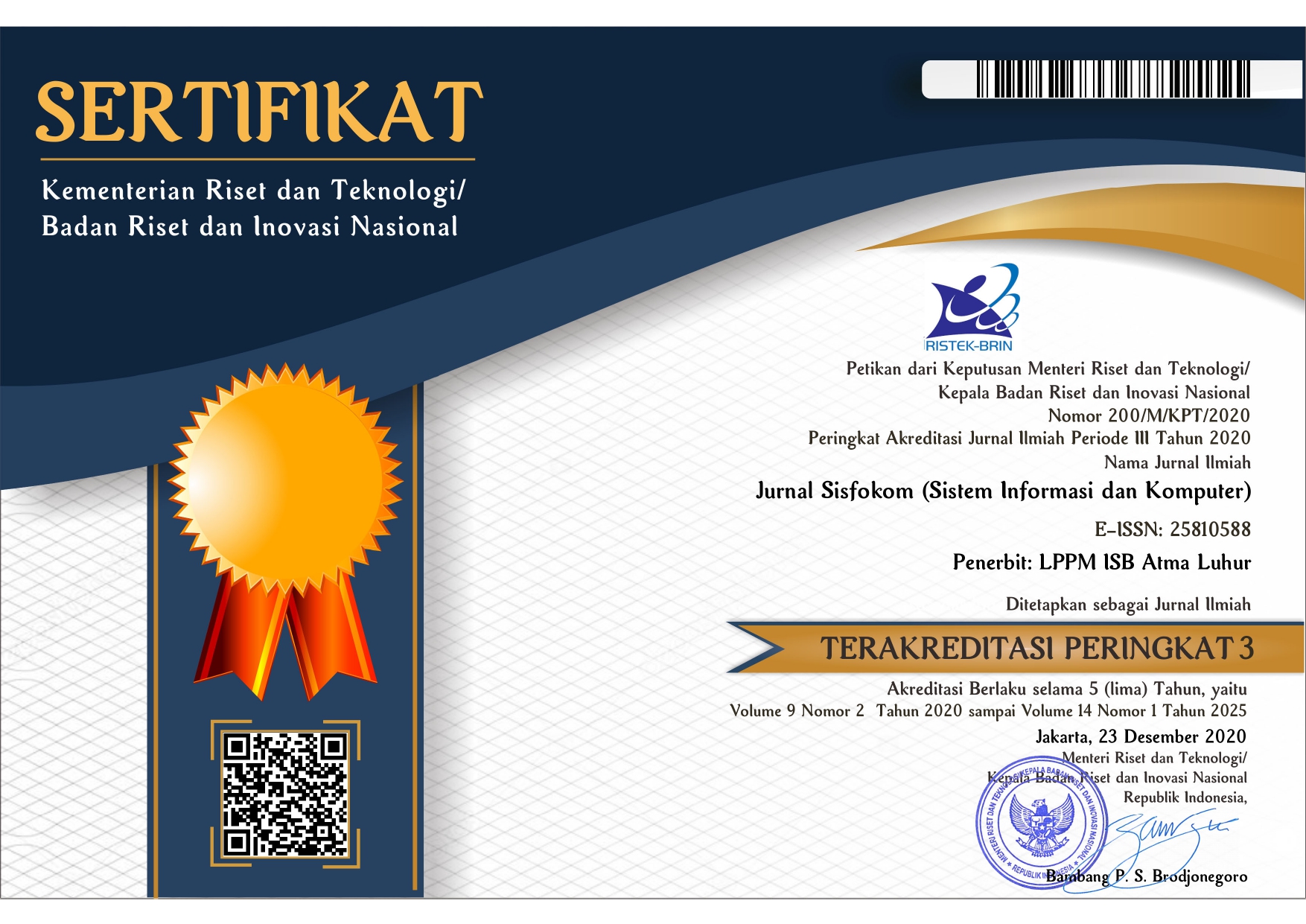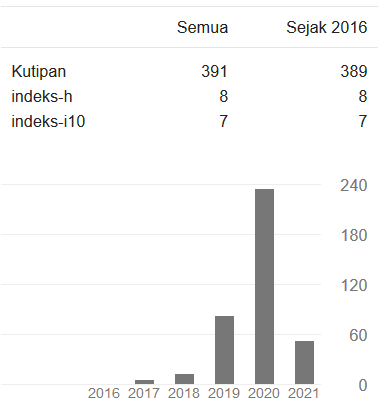Classification of Final Project Titles Using Bidirectional Long Short Term Memory at the Faculty of Engineering Nurul Jadid University
DOI:
https://doi.org/10.32736/sisfokom.v12i3.1723Keywords:
Final project, Classification text, BiLSTM, Hyperparameter turningAbstract
Every year, the Faculty of Engineering at Nurul Jadid University forms a committee to manage the process of students' final projects from the title selection stage to the final examination process until graduation. The process of selecting the final project title is still done manually, namely by checking the titles one by one, which takes a long time and allows errors because there is a lot of data to check, so human errors can also occur. Therefore, this research proposes to use the Bidirectional Long Short Term Memory (BiLSTM) method to classify the final project title based on its grade category. Several experiments were conducted to generate the most appropriate labels. The first experiment produced 4 labels and the second experiment produced 2 labels. From the results of several experiments, it was concluded that the second experiment had the best accuracy results with the 'good enough' and 'good' classes. The oversampling technique was then applied to overcome overlapping data, and the turning process was then performed on several parameters that could re-optimize the previous accuracy result of 75.24% to 91.15%. With a configuration of 10 random state parameters, using 64 batch sizes and 50 epochs. In addition, model adjustments were made to the hidden layer by adding a dropout layer and relu activation.References
A. Arizal, A. N. Puteri, F. Zakiyabarsi, and D. F. Priambodo, “Metode Prototype pada Sistem Informasi Manajemen Tugas Akhir Mahasiswa Berbasis Website,” J. Teknol. Inf. dan Komun., vol. 10, no. 1, pp. 1–8, 2022.
T. Tuononen and A. Parpala, “The role of academic competences and learning processes in predicting Bachelor’s and Master’s thesis grades,” Stud. Educ. Eval., vol. 70, p. 101001, Sep. 2021, doi: 10.1016/J.STUEDUC.2021.101001.
N. Nurdin, M. Suhendri, Y. Afrilia, and R. Rizal, “Klasifikasi Karya Ilmiah (Tugas Akhir) Mahasiswa Menggunakan Metode Naive Bayes Classifier (NBC),” SISTEMASI, vol. 10, no. 2, pp. 268–279, 2021.
R. Rais, A. Rakhman, and A. H. Sulasmoro, “Rekomendasi Tema Tugas Akhir Menggunakan Metode Clasifikasi Supervised Learning,” Smart Comp Jurnalnya Orang Pint. Komput., vol. 11, no. 3, pp. 535–540, 2022.
B. D. Laraswati, “Human Error: Pengertian dan Jenis-Jenisnya,” 2022. https://blog.algorit.ma/human-error-pengertian-dan-jenis-jenisnya/ (accessed Mar. 15, 2023).
M. Liang and T. Niu, “Research on Text Classification Techniques Based on Improved TF-IDF Algorithm and LSTM Inputs,” Procedia Comput. Sci., vol. 208, pp. 460–470, Jan. 2022, doi: 10.1016/J.PROCS.2022.10.064.
A. Cindy Rahayu, “Klasifikasi Teks – MTI,” 2020. https://mti.binus.ac.id/2020/09/03/klasifikasi-teks/ (accessed Mar. 15, 2023).
H. Ying, C. Deng, Z. Xu, H. Huang, W. Deng, and Q. Yang, “Short-term prediction of wind power based on phase space reconstruction and BiLSTM,” Energy Reports, vol. 9, pp. 474–482, Sep. 2023, doi: 10.1016/j.egyr.2023.04.288.
H. Jelodar, Y. Wang, R. Orji, and S. Huang, “Deep sentiment classification and topic discovery on novel coronavirus or COVID-19 online discussions: NLP using LSTM recurrent neural network approach,” IEEE J. Biomed. Heal. Informatics, vol. 24, no. 10, pp. 2733–2742, 2020.
C. Sitaula and T. B. Shahi, “Multi-channel CNN to classify nepali covid-19 related tweets using hybrid features,” arXiv Prepr. arXiv2203.10286, 2022.
H. Wu, Z. He, W. Zhang, Y. Hu, Y. Wu, and Y. Yue, “Multi-class text classification model based on weighted word vector and bilstm-attention optimization,” in Intelligent Computing Theories and Application: 17th International Conference, ICIC 2021, Shenzhen, China, August 12–15, 2021, Proceedings, Part I 17, 2021, pp. 393–400.
D. R. Alghifari, M. Edi, and L. Firmansyah, “Implementasi Bidirectional LSTM untuk Analisis Sentimen Terhadap Layanan Grab Indonesia,” J. Manaj. Inform., vol. 12, no. 2, pp. 89–99, 2022.
R. Z. Insani, C. Setianingsih, and T. W. Purboyo, “Analisis Sentimen Komentar Berdasarkan Geo Tagged Menggunakan Algoritma Bilstm,” eProceedings Eng., vol. 10, no. 1, 2023.
A. P. Wibowo, W. Widiyono, A. Saifudin, and A. S. Darmawan, “Naïve Bayes, Neural Network dan K-Nearest Neighbor untuk Klasifikasi Topik Tugas Akhir,” Smart Comp Jurnalnya Orang Pint. Komput., vol. 11, no. 4, pp. 661–667, 2022.
N. Andriani and A. Wibowo, “Implementasi Text Mining Klasifikasi Topik Tugas Akhir Mahasiswa Teknik Informatika Menggunakan Pembobotan TF-IDF dan Metode Cosine Similarity Berbasis Web,” in Prosiding Seminar Nasional Mahasiswa Bidang Ilmu Komputer dan Aplikasinya, 2021, vol. 2, no. 2, pp. 130–137.
S. Sumarni and S. Rustam, “Klasifikasi Topik Tugas Akhir Mahasiswa menggunakan Algoritma Particle Swarm Optimization dan K-Nearest Neighbor,” Ilk. J. Ilm., vol. 12, no. 2, pp. 168–175, 2020.
F. N. Fajri and S. Syaiful, “Klasifikasi Nama Paket Pengadaan Menggunakan Long Short-Term Memory (LSTM) Pada Data Pengadaan,” Build. Informatics, Technol. Sci., vol. 4, no. 3, pp. 1625–1633, 2022.
W. Afandi, S. N. Saputro, A. M. Kusumaningrum, H. Adriansyah, M. H. Kafabi, and S. Sudianto, “Klasifikasi Judul Berita Clickbait menggunakan RNN-LSTM,” J. Inform. J. Pengemb. IT, vol. 7, no. 2, pp. 85–89, 2022.
A. D. D. Wibiyanto and A. Wibowo, “Penerapan Algoritma Multiclass Support Vector Machine dan TF-IDF Untuk Klasifikasi Topik Tugas Akhir,” SKANIKA Sist. Komput. dan Tek. Inform., vol. 6, no. 1, pp. 42–50, 2023.
E. Subowo, F. A. Artanto, I. Putri, and W. Umaedi, “BLTSM untuk analisis sentimen berbasis aspek pada aplikasi belanja online dengan cicilan,” J. FASILKOM, 2022.
M. Kowsher et al., “LSTM-ANN & BiLSTM-ANN: Hybrid deep learning models for enhanced classification accuracy,” Procedia Comput. Sci., vol. 193, pp. 131–140, Jan. 2021, doi: 10.1016/J.PROCS.2021.10.013.
J. Song, “Aspect-Based Sentiment Analysis on Mobile Game Reviews Using Deep Learning,” Grad. Sch. Comput. Inf. Sci. Hosei Univ, 2020.
K. Chowdhury, “10 Hyperparameters to keep an eye on for your LSTM model — and other tips | by Kuldeep Chowdhury | Geek Culture | Medium,” Geek Culture, 2021. https://medium.com/geekculture/10-hyperparameters-to-keep-an-eye-on-for-your-lstm-model-and-other-tips-f0ff5b63fcd4 (accessed May 09, 2023).
D. Passos and P. Mishra, “A tutorial on automatic hyperparameter tuning of deep spectral modelling for regression and classification tasks,” Chemom. Intell. Lab. Syst., vol. 223, p. 104520, Apr. 2022, doi: 10.1016/J.CHEMOLAB.2022.104520.
F. N. Fajri, A. Tholib, and W. Yuliana, “Penerapan Machine Learning untuk Penentuan Mata kuliah Pilihan pada Program Studi Informatika,” J. Tek. Inform. dan Sist. Inf. p-ISSN, vol. 2443, p. 2210.
Lakshana, “Artificial Intelligence Vs Machine Learning Vs Deep Learning,” Analytics Vidhya, 2021. https://www.analyticsvidhya.com/blog/2021/05/ai-ml-dl/ (accessed May 11, 2023).
G. Wei, W. Mu, Y. Song, and J. Dou, “An improved and random synthetic minority oversampling technique for imbalanced data,” Knowledge-Based Syst., vol. 248, p. 108839, Jul. 2022, doi: 10.1016/J.KNOSYS.2022.108839.
Downloads
Additional Files
Published
Issue
Section
License
The copyright of the article that accepted for publication shall be assigned to Jurnal Sisfokom (Sistem Informasi dan Komputer) and LPPM ISB Atma Luhur as the publisher of the journal. Copyright includes the right to reproduce and deliver the article in all form and media, including reprints, photographs, microfilms, and any other similar reproductions, as well as translations.
Jurnal Sisfokom (Sistem Informasi dan Komputer), LPPM ISB Atma Luhur, and the Editors make every effort to ensure that no wrong or misleading data, opinions or statements be published in the journal. In any way, the contents of the articles and advertisements published in Jurnal Sisfokom (Sistem Informasi dan Komputer) are the sole and exclusive responsibility of their respective authors.
Jurnal Sisfokom (Sistem Informasi dan Komputer) has full publishing rights to the published articles. Authors are allowed to distribute articles that have been published by sharing the link or DOI of the article. Authors are allowed to use their articles for legal purposes deemed necessary without the written permission of the journal with the initial publication notification from the Jurnal Sisfokom (Sistem Informasi dan Komputer).
The Copyright Transfer Form can be downloaded [Copyright Transfer Form Jurnal Sisfokom (Sistem Informasi dan Komputer).
This agreement is to be signed by at least one of the authors who have obtained the assent of the co-author(s). After submission of this agreement signed by the corresponding author, changes of authorship or in the order of the authors listed will not be accepted. The copyright form should be signed originally, and send it to the Editorial in the form of scanned document to sisfokom@atmaluhur.ac.id.









